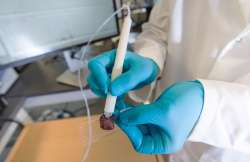Finding out cancer cells in body is a just a matter of 10 seconds with the new ‘MasSpec Pen’
Cancer surgeons now can detect presence of cancerous cells in the tissue in just 10 seconds.

Missing out on some of the diseased tissue while carrying out the cancer surgery used to be one of the biggest fears of cancer surgeons. But it won’t be any longer. A novel pencil-sized tool developed by scientists and engineers at the University of Texas at Austin can eliminate the chances of missing the cancer tissues. The study was published on Wednesday. This tool is named as MasSpec Pen, which helps the surgeons to detect cancerous cells while removing the tumour, in seconds.
It helps them know if they removed all of the cancer cells completely. With the current technology, surgeons couldn’t determine whether they have removed everything. If they miss any cancer cell it could lead to a return of cancer or at least, another operation would be required to clean up the affected tissues.
The study in Science Translational Medicine said that the pen can find cancerous tissue during surgery in about 10 seconds.
The MasSpec Pen is touched to the tissue during surgery, drawing up small molecules for analysis by a miniaturized mass spectrometer build inside the stylus. It can identify the cancerous cells through distinct molecules called metabolites.
"Each type of cancer produces a unique set of metabolites and other biomarkers that act as fingerprints," the study said.
This identifies any residual cancerous cell in seconds with a monitor linked to the pen declaring ‘normal’ or ‘cancer’. This facilitates the surgeons to keep cleaning out the cancer cells until they have cleared all signs of cancer. Surgeons can decide if they can leave the tissue inside the patient’s body.
Tests on tissues removed from 253 human cancer patients showed the new tool was "more than 96 percent accurate," according to the study.
"Any time we can offer the patient a more precise surgery, a quicker surgery or a safer surgery, that's something we want to do," said James Suliburk, head of endocrine surgery at Baylor College of Medicine and a collaborator on the project.
"This technology does all three. It allows us to be much more precise in what tissue we remove and what we leave behind," he said.
For more Lifestyle updates, follow our Facebook page.